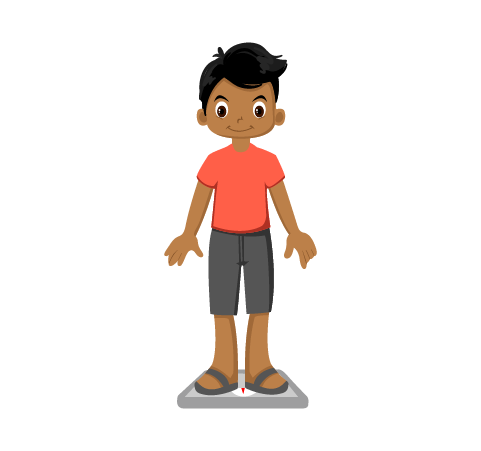Home Child Growth Calculator BMI Calculator Browse Peadiatricians Our Services
Child BMI Calculator
BMI (Body Mass Index) is used to determine whether a person is of a healthy weight, underweight or overweight (obese). Our child BMI calculator will help you assess your child’s overall health. If the BMI of a child is within the healthy range it is good, but when it is outside of the permissible range the health risks your child might be prone to might increase significantly. Like the name suggests, the Body Mass Index takes into consideration the height and weight of the child. The BMI changes since the body fat of a child changes with age. There is a difference in the amount of body fat in each gender as they mature, this can be calculated with the help of our child BMI calculator.
Enter your child's details

Enter your child's details
Child BMI Calculator

Age : 2years 4months
Height : 120cm
Weight : 16kg
BMI Percentile : 90th Percentile
Your child's BMI is HIGH. Consult immediately with top quality pediatricians to ensure your child's height and weight reach a normal level.
*based on medical standards
Your child's BMI is HIGH. Consult immediately with top quality pediatricians to ensure your child's height and weight reach a normal level.
*based on medical standards
The BMI formula for child and adults is kg/m2., The following table shows the range of BMI values and how to interpret them
| WEIGHT | BMI |
|---|---|
| Underweight | Less than 18.5 |
| Healthy weight | 18.5 to 24.9 |
| Overweight | 25 to 29.9 |
| Obese | Above 30 |
Doctors determine the BMI of a child with routine checkups and compare these measurements against other kids of the same age. The BMI calculator for kids helps in determining the value of the Body Mass Index along with the percentile of the BMI value.
This is done mainly because doctors need to understand what the changes that come with age are. Separate growth tracking charts are used for boys and girls to take into account the difference in growth rates and how the amount of body fat changes as both the genders mature. The growth of the child can be tracked with several visits to the doctor along with the pattern of measurements.
BMI calculator for kids is very helpful when trying to identify kids or teenagers who might be at risk of becoming obese as they grow older. As kids grow the connection between BMI and body fat also increases. Doctors can identify the kids who are on the borderline or at risk and monitor their body fat to avoid adult obesity. The BMI calculator for kids uses the child weight by age to calculate the index, making it age specific.
The child weight by age is used in order to get an accurate result in the BMI formula for child.
BMI percentiles exhibit how the measurements of your child compares to others of the same age and gender. An example would be a child with a BMI in the 75th percentile, this would mean that 75% of kids in the same age and sex had a lower BMI.
Kids can have a higher BMI if they are muscular or have a large frame however, this might not be taken into consideration by the BMI calculator for kids. At the same time, kids with a smaller frame tend to have a lower BMI or normal BMI but not much of body fat, which again isn’t considered by the BMI calculator for kids. This difference can be due to the BMI formula for child which calculates the BMI using the child weight by age. Kids measuring between the 85th and 94th percentile are considered to be overweight. The reason for this is because of the excess body fat. A child with a BMI between the 5th and 85th percentile are considered to be in a healthy weight range. If the BMI of a child is below the 5th percentile the child is considered to be underweight. If your child is underweight, you can read our blog on the best foods for baby weight gain to help improve your child’s diet.
While you can calculate your BMI online with the help of mfine BMI calculator tool. mfine also provides a BMI chart for children by age. The real value of these measurements are in viewing them over time as a pattern. This allows doctors as well as parents to observe the growth of a child to determine whether the rate of growth is normal in comparison to similarly aged kids.